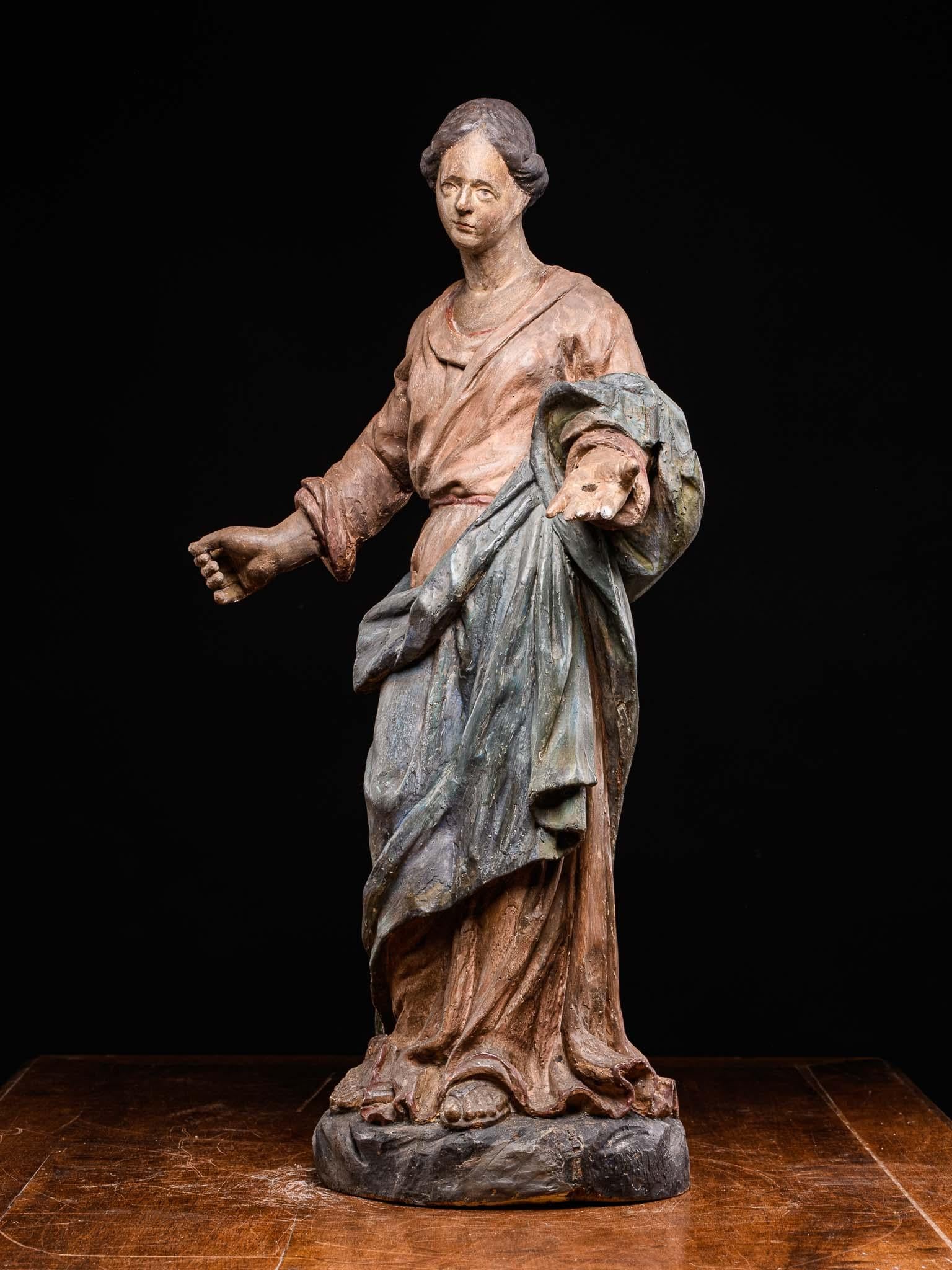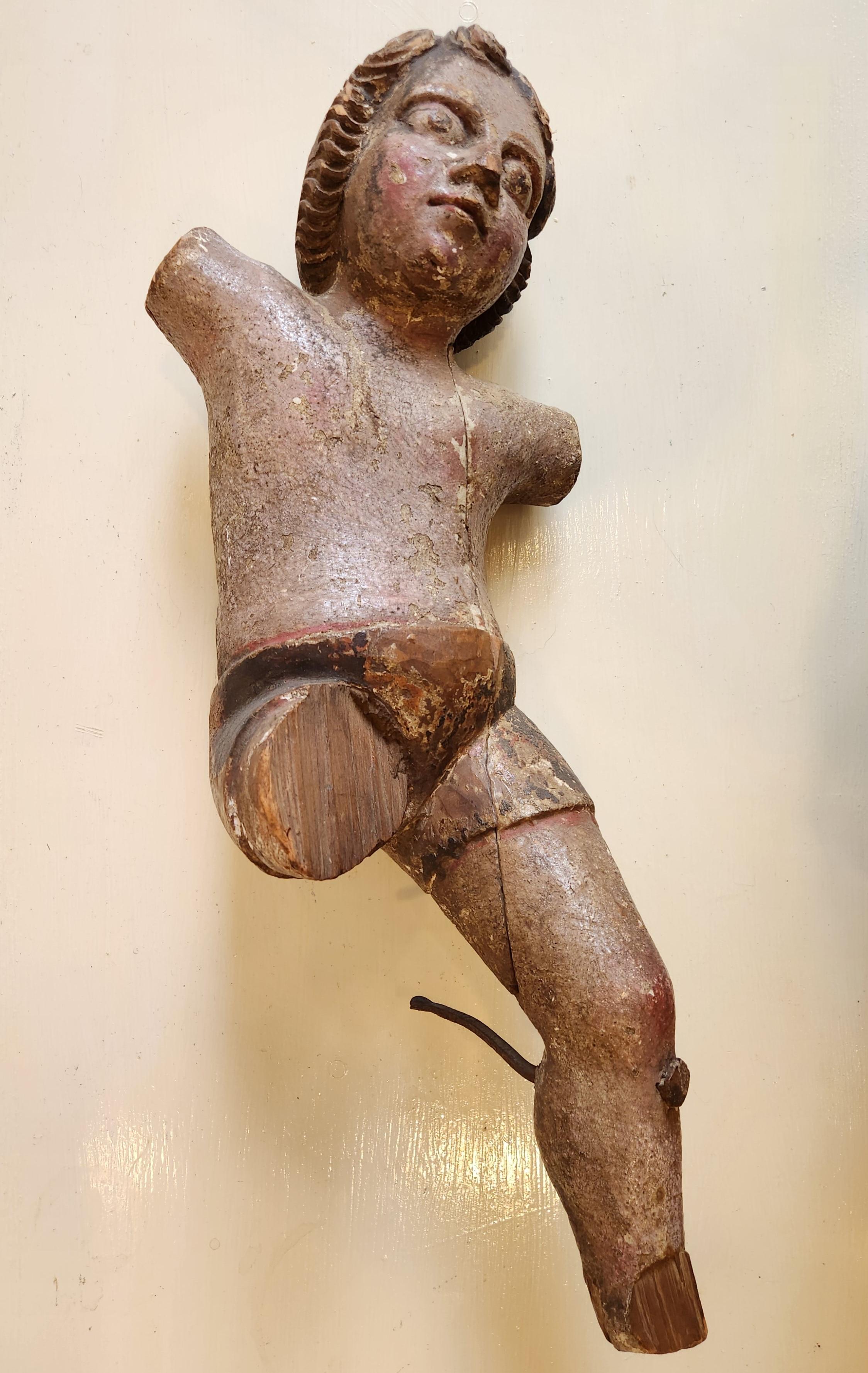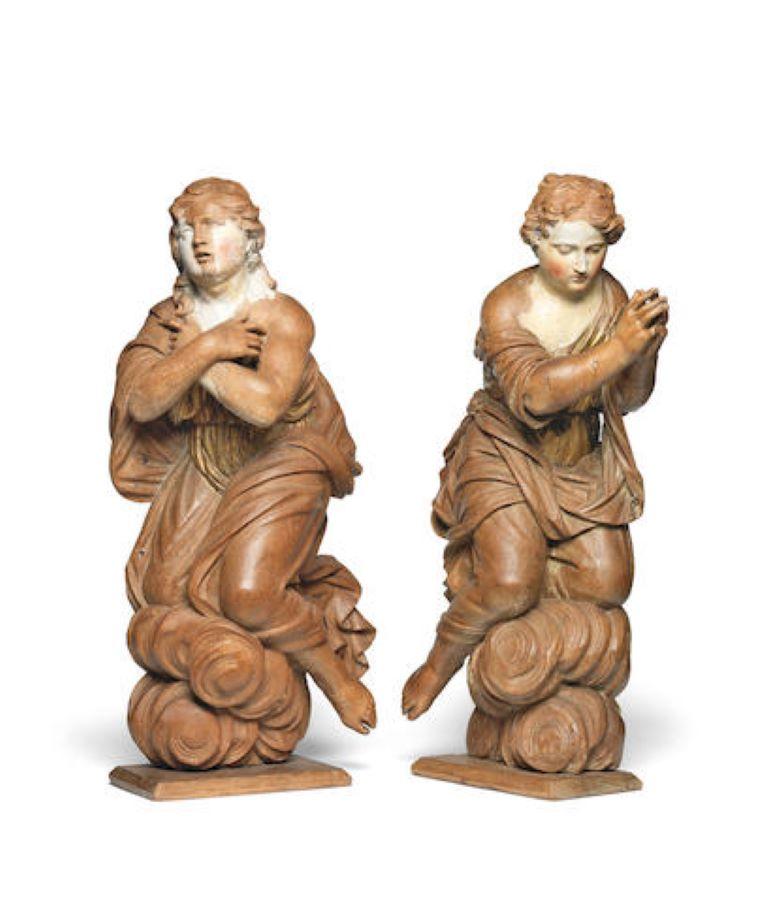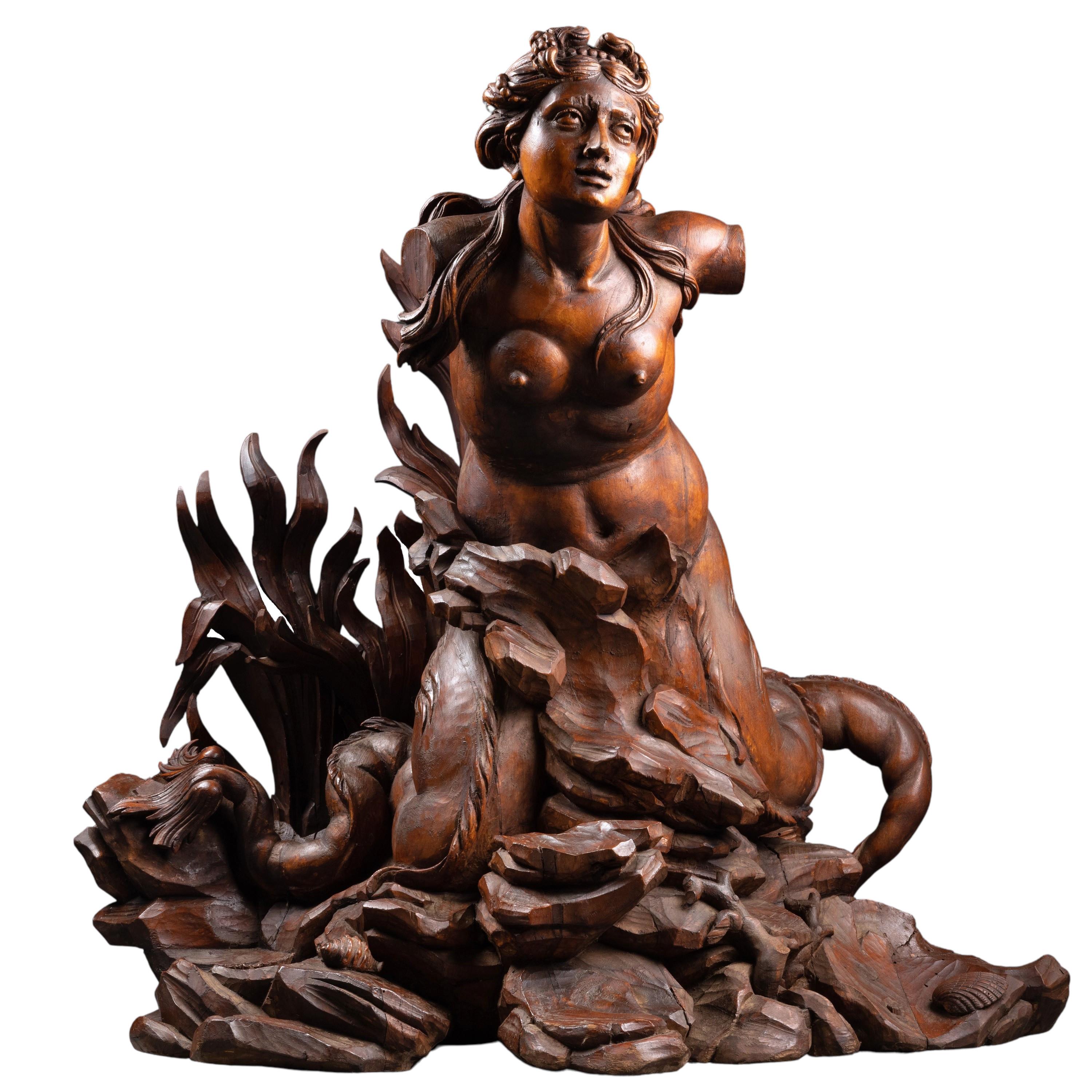Items Similar to A Spanish Statue of a Sitting on a Pedestal Angel with Open Arms, Early 19th C
Video Loading
Want more images or videos?
Request additional images or videos from the seller
1 of 13
UnknownA Spanish Statue of a Sitting on a Pedestal Angel with Open Arms, Early 19th CEarly 19th Century
Early 19th Century
About the Item
Description: A Spanish Statue of a Sitting on a Pedestal Angel with Open Arms in polychromed wood, Early 19th Century
Statue: Statue of an Angel
Object Type: Statuette
Artist, Sculptor / Maker: Unknown
Place of Origin: Spain
Period: Early 19th Century
Materials and Techniques: Polychromed wood
Categories: Christianity
Style: Baroque
Dimensions: H. 48 cm D. 24 cm W. 27 cm, Pedestal: 22,50 x 11,50 cm
History:
Angels have been present in works of art since early Christianity. They bring peace to those who grieve and give them comfort that their loved ones are being watched over in eternity. Angels serve as a transition between the earthly realm and the heavenly and symbolise beauty, strength, faith and protection.
Physical Description:
A magnificent statue in polychromed wood on a pedestal of a sitting Angel with open arms.
The angel wears a tight fitting floral dress with a decorated gold border. The flesh is painted in natural colours. The name TERE can be seen centrally on the carved baroque pedestal. TERE is a Spanish name for girls. The meaning is `summer, harvester`.
Historical Significance:
The facial features and dress indicate a Spanish origin. The statue of An Angel is a rare specimen because of its physical condition and original colouring and gilding.
- Creation Year:Early 19th Century
- Dimensions:Height: 18.9 in (48 cm)Width: 10.63 in (27 cm)Depth: 9.45 in (24 cm)
- Medium:
- Movement & Style:
- Period:
- Condition:A Statue of an Angel is in a good condition and preserved colouring. This work is offered in ready to collect gallery condition, having been professionally revised.
- Gallery Location:Bruges, BE
- Reference Number:1stDibs: LU2006212817292
About the Seller
5.0
Vetted Seller
These experienced sellers undergo a comprehensive evaluation by our team of in-house experts.
Established in 1998
1stDibs seller since 2022
14 sales on 1stDibs
Typical response time: 5 hours
- ShippingRetrieving quote...Ships From: Bruges, Belgium
- Return PolicyA return for this item may be initiated within 14 days of delivery.
More From This SellerView All
- A French Statue of Saint John the Baptist, Circa 1700, polychromed woodLocated in Bruges, BEDescription: A French Statue of Saint John the Baptist with Staff and Lamb on his Feet, Circa 1700, polychromed wood Statue: Shepherd with Lamb on his Feet Object Type: Religious St...Category
17th Century Baroque Figurative Sculptures
MaterialsPaint, Wood
- A Spanish Statue of the Virgin Mary with Child Jezus, circa 1600Located in Bruges, BEDescription: A Spanish Statue of the Virgin Mary with Child Jezus, Circa 1600, polychromed wood Statue : Madonna and Child Object Type: Statuette Artist, Sculptor / Maker: Unknown Place of Origin: Spain Period: Circa 1600 Materials and Techniques: Polychromed wood Categories: Christianity Style: Renaissance Dimensions: H. 45 cm D. 13 cm W. 15 cm History: The Madonna and Child is one of the most easily recognisable, most frequently produced themes in the history of Art and has been depicted by many famous artists, including Michelangelo, Leonardo da Vinci, and Raphael. The word Madonna is derived from the Italian 'ma donna,' or 'my lady' and is used to describe Mary, the mother of Christ. The Madonna and Child depict a loving mother and son, which is a symbol of hope, faith, and love and represents the love and bond between mother and child, and is a symbol of hope and protection. Physical Description: A magnificent statue in polychromed wood of standing Madonna and Child. Virgin Mary is holding Her Son in Her left arm. Together with Jesus Christ They are holding the World in Their hands to show that They are together and our Heavenly king on Earth and His Mother is our Queen. She wears a tight fitting golden red dress; over this is a red mantle; Her mantle is lined blue and is with an ochre gold border. The flesh is painted in natural colours and Her long hair lies over both shoulders. The Child Jesus wears a green long sleeves dress. With His right hand He gives a blessing and represents Trinitarian love. In addition to signifying a blessing or that the Lord is speaking, this position conveys doctrinal truth, the three uplifted fingers depict the unity of God in the Holy Trinity (Father, Son, and Holy Spirit). Historical Significance: The facial features and drapery which envelopes the body point to Spanish origin. The statue of Virgin Mary...Category
16th Century Renaissance Figurative Sculptures
MaterialsWood
- A Spanish Gothic Statue of Saint Mary Magdalene, Late 15th CenturyLocated in Bruges, BEDescription: A Spanish Gothic Statue of Saint Mary Magdalene, Late 15th Century, polychromed wood Statue: Saint Mary Magdalene Object Type: Statuet...Category
15th Century and Earlier Gothic Figurative Sculptures
MaterialsWood
- A Flemish Statue of Crowned Virgin Mary with Child Jesus, 17th CenturyLocated in Bruges, BEDescription: A Flemish Statue of Crowned Virgin Mary with Child Jesus, 17th Century, polychromed wood, silver crowns Statue: Crowned Madonna and Child Object Type: Statuette Artist, Sculptor / Creator: Unknown Place of Origin: Flanders Period: 17th Century Style: Renaissance Materials and Techniques: Polychromed wood, Silver Categories: Christianity Dimensions: H. 55 cm D. 15 cm W. 19 cm History: The Madonna and Child is one of the most easily recognisable, most frequently produced themes in the history of Art and has been depicted by many famous artists, including Michelangelo, Leonardo da Vinci, and Raphael. The word Madonna is derived from the Italian 'ma donna,' or 'my lady' and is used to describe Mary, the mother of Christ. The Madonna and Child depict a loving mother and son, which is a symbol of hope, faith, and love and represents the love and bond between mother and child, and is a symbol of hope and protection. Purity or virginity is represented by the color of clothing of Madonna. The color blue symbolises purity, virginity, and royalty. Physical Description: A magnificent 17th Century statue in polychromed wood of standing Madonna and Child. Virgin Mary is holding a small staff that is often shown in the hands of a king or queen. In Her left arm She is holding Her Son, Jesus Christ who is holding the World in His left hand to show that He is our Heavenly king on Earth and His Mother is our Queen. She wears a tight fitting golden dress with blue sleeves; over this is a blue mantle; Her mantle is lined red and is with an ochre gold border. The flesh is painted in natural colours and Her long hair lies over both shoulders. The Child Jesus wears a blue long sleeves dress...Category
17th Century Renaissance Figurative Sculptures
MaterialsWood
- The Flagellation of Christ, Old Master, Flemish School, Oil on copperLocated in Bruges, BEThe Flagellation of Christ Old Master Flemish School 17th century Medium: Oil on copper Dimensions: Image size 22 x 17 cm, frame size 39 x 31 cmCategory
17th Century Baroque Portrait Paintings
MaterialsCopper
- Roaring Deer Stag, Carl Friedrich Deiker, Wetzlar 1836 – 1892 Düsseldorf, SignedLocated in Bruges, BERoaring Deer Stag Deiker Carl Friedrich Wetzlar, Germany 1836 – 1892 Dusseldorf, Germany German Painter Signature: Signed bottom right Medium: Oil on canvas Dimensions: Image size 58 x 81 cm, frame size 73 x 96 cm Biography: Deiker Carl Friedrich was born on April 3, 1836 in Wetzlar. He was a Prussian animal painter. Deiker was specialised in animal genres related to hunting and wildlife. He also illustrated magazines and books on hunting. Carl Friedrich Deiker was the son of Friedrich Deiker, a painter and drawing teacher at the high school. His older brother, Johannes Deiker, with whom he learned to draw after their father’s death in 1843, was a painter specialising in hunting scenes. Deiker attended the Hanau drawing Academy, where he was a pupil of the director Theodor Pélissier (1794-1863), and then studied at Johann Wilhelm Schirmer’s studio in Carlsruhe. In 1859, in the Reinhardswald forest, he collected studies for his large hunting paintings...Category
19th Century Baroque Animal Paintings
MaterialsCanvas, Oil
You May Also Like
- Late 17th C, Baroque, Saint, Italian School, Wooden Sculpture of Saint AnthonyLocated in brussel, BEThe impressive life-size statue of St. Anthony (Lisbon, 1195 – Padua, 1231) used to be probably in a church or monastery of the mendicant order of the Franciscans. You can immediately recognize a Franciscan monk by his brown habit, brown hooded cloak...Category
17th Century Baroque Figurative Sculptures
MaterialsWood
- 17th C Polychromed fruitwood carved statue depicting Madonna, France.Located in brussel, BEAn exceptionally beautiful antique French wood carving, made in the 17th century. It depicts Madonna standing with open offering arms .The...Category
17th Century Baroque Figurative Sculptures
MaterialsWood
- Polychrome Carved Mexican Sculpture -- Child JesusLocated in Troy, NYThis is a hand-carved wood polychromed sculpture of the Infant Jesus. A baroque figure probably from the 18th century, this religious figure was obtained in Mexico. It appears to hav...Category
18th Century Baroque Figurative Sculptures
MaterialsWood, Paint
- A pair of late 17th century Northern European carved oak angelsLocated in Bath, SomersetA pair of carved oak angels, circa 1700, with a lovely warm patina and faint traces of polychrome to the face and gilding to the body. The angels are both kn...Category
17th Century Baroque Figurative Sculptures
MaterialsOak
- A late 17th Italian carved limewood figure of Mermaid, circle of Filippo ParodiLocated in PARIS, FRA late 17th c. Italian carved figure of Mermaid, Circle of Filippo Parodi (Genoa, 1630 – July 22, 1702) Dimensions: h. 29.13 in, w. 30.31 in, p. 18.9 in (at the base) Magnificent...Category
Late 17th Century Baroque Figurative Sculptures
MaterialsWood
- Tuscan Baroque Nude Putto Candle Holder 17-18 century gilded woodLocated in Florence, ITOne flame candle holder putto made of gilded wood. Those kind of objects were present in churches or noble villas, specially during the Baroque times. The base is not coeval.Category
17th Century Baroque Nude Sculptures
MaterialsGold





